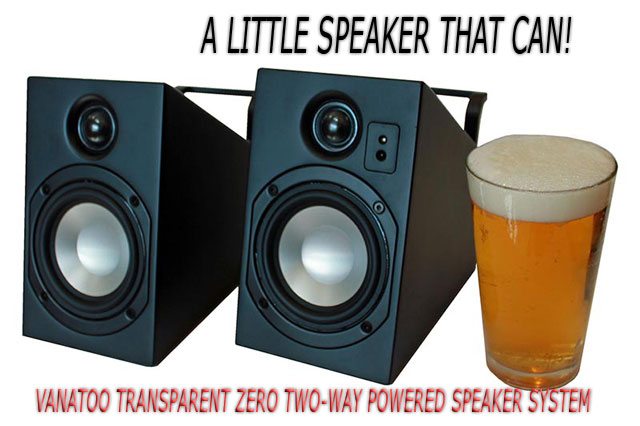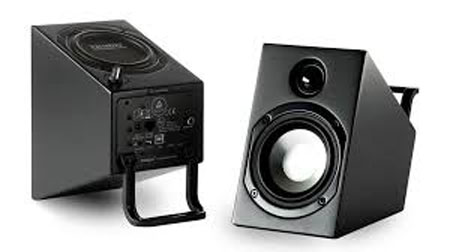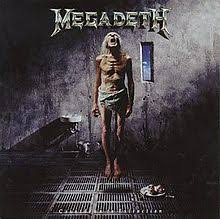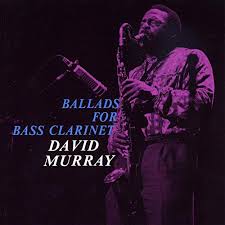Vanatoo Transparent Zero Two-way Powered Speaker System

No Dancing in the Office
 For the most part, I still listen to music through gear that was state of the art in 1957, vacuum tubes and that great technological leap, stereo playback. My youngest turntable is thirty years old and my oldest is about seventy. Aside from the sound, I like physical media. I like records. Hell, I’m even ok with the occasional compact disc, although my CD player died a few months ago.
For the most part, I still listen to music through gear that was state of the art in 1957, vacuum tubes and that great technological leap, stereo playback. My youngest turntable is thirty years old and my oldest is about seventy. Aside from the sound, I like physical media. I like records. Hell, I’m even ok with the occasional compact disc, although my CD player died a few months ago.
There is one place, though, where my Luddism deprives me of listening pleasure: the office. It’s just not practical to set up even a small system there, not the least because I share that space with a coworker who believes himself to be maturing at twenty-seven, and I’m not sure the stuff he listens to even qualifies music.
Doubling down on this tragic situation, our famously parsimonious IT department provides computer speakers that, frankly, suck. They’re little plastic things that feign to be two-ways, but it’d be a pretty good bet that there’s no crossover in there. They weigh about a pound each, suggesting that the drivers have magnets that are smaller than the ones stuck to the refrigerator, and they have a volume knob that generates more static noise than Fox News. I’ve heard announcements on New York City subway cars with better clarity than this wreckage.
Even more unfortunate, there’s a large block of time during my workday that’s perfect for listening to music. I hit my desk about 6AM most mornings, which gives me about three hours with the office to myself; time where the only thing I have for company is rustling paperwork, and that just doesn’t swing, man.
This is a problem that is clearly requires a solution.
A Savior in the D.C. Suburbs
 Our now annual trip to Rockville Maryland for Capital Audiofest is always a good time. The show has grown steadily over the past few years and now includes vendors hawking wares from a few dollars for little tweaks to a million-dollar super system, and everything in between.
Our now annual trip to Rockville Maryland for Capital Audiofest is always a good time. The show has grown steadily over the past few years and now includes vendors hawking wares from a few dollars for little tweaks to a million-dollar super system, and everything in between.
Some of the most interesting rooms are the ones where the designer has built a theoretically better mousetrap and has come to explain his or her – although it’s almost always his – unique perspective to anyone who’ll listen. Some of the folks in this category, like Klaus Bunge of Odyssey Audio, are well established in the marketplace and attract big crowds (Klaus is very entertaining), but more frequently these rooms represent relatively new startup companies eager to tell you about their version of the next big thing.
One of these newer companies is a six-year-old powered speaker manufacturer, Vanatoo. I’d seen them at the show two years running, and their lineup of three models and a few accessories has been noteworthy both times, both for the sound and the unusually affordable price of entry. Their room was crowded this year; a good sign that listeners are paying attention.
All of Vanatoo’s speakers are self-powered two-ways with a variety of digital and analog inputs. Even in a hotel room, with famously compromised acoustics, they sounded great. I spoke at length with Vanatoo co-founder Rick Kernan, and it seemed like he might have a solution to my music-free situation at the office, so we arranged to do a review of Vanatoo’s smallest and most affordable model, the Transparent Zero, which in addition to sounding promising also seemed like it would be the best fit for my small space.


The Vanatoo Transparent Zero
 The Vanatoo Transparent Zero speakers are solid little chunks of electronics priced at a very reasonable $359.00. They’re black and shaped a little like the wheel chocks you might see under a semi-truck turned up on their end, with a 7.5” tall angled face. The active driver compliment consists of a one-inch soft dome tweeter and a four-inch aluminum mid/woofer with a rubber surround in each box. There is also a four-inch passive radiator mounted on the top and a curved metal handle that sticks up in the back. Depending on your listening position, the speaker can be flipped so the tweeter is under the mid/woofer, in which case the handle becomes a stand. Each pair of speakers has four 48-watt class D amplifiers – presumably one per active driver. The right speaker has all the external source connections and volume knob, with an umbilical cord connecting the two units.
The Vanatoo Transparent Zero speakers are solid little chunks of electronics priced at a very reasonable $359.00. They’re black and shaped a little like the wheel chocks you might see under a semi-truck turned up on their end, with a 7.5” tall angled face. The active driver compliment consists of a one-inch soft dome tweeter and a four-inch aluminum mid/woofer with a rubber surround in each box. There is also a four-inch passive radiator mounted on the top and a curved metal handle that sticks up in the back. Depending on your listening position, the speaker can be flipped so the tweeter is under the mid/woofer, in which case the handle becomes a stand. Each pair of speakers has four 48-watt class D amplifiers – presumably one per active driver. The right speaker has all the external source connections and volume knob, with an umbilical cord connecting the two units.
In addition to all of that – and that’s already a lot – The Transparent Zero’s input options include USB, Toslink Optical, and a one-eighth inch analog jack. Built in digital signal processing converts USB at 48k at 16 bits and Toslink at up to 96k at 24 bits. At the office I connected the USB from my desktop tower and the analog input from my iPhone. To get started, simply connect the two speakers to each other, plug them into the wall, connect to your source and hit play.
I situated the T-Zeroes on either side of my two screen monitors, about thirty-six inches apart and, initially, toed in at a 90-degree angle to each other, leaving them pointing more-or-less directly at my chest, an admittedly small soundstage but geometrically similar to the way my floorstanders are setup at home. Further experimentation found that they sounded far better with the angle turned outward aimed at about the outside of my shoulders. In this very near-field application the adjustment enlarged and deepened the soundstage appreciably.
The Sources at Hand
I’m going to state right up front that using the CD transport in my office computer using Windows Media Player and the supplied USB cable was disappointing. It sounded dead and very much like a 1960s era battery powered portable transistor radio, and not at all like the very well turned out sound I’d heard at the show. But, after listening with some other sources, I’m certain this mediocre performance was due to the computer and not the speakers. I only mention this to reinforce that well-worn hi-fi cliché: garbage in, garbage out, which is to say, your sources still matter even if you’re trucking in the digital domain.
Now, I’m well aware that an iPhone is no substitute for, say, a dozen pushing and pulling 6550 tubes, which is what I’d be listening to in my main system (more old-fashioned stuff). However, the iPhone was definitely a step up from my desktop computer as a source. I’ve always made a point of burning CDs in the lossless format and the relatively few albums and songs I’ve downloaded have always been done in the Apple’s ALAC format to at least attempt to preserve the quality of the signal.
I’ve generally only used my phone for music in situations where portability is a requirement – working out or riding the bus or the like – and I’d only ever used it with ear-buds. I never have any expectation that it’s going to sound anywhere near as good as my home system, but the files loaded into it do sound reasonably good considering the inherent limitations of the equipment. The Transparent Zeroes are the first time I’ve ever hooked my iPhone into anything that reproduces sound with an actual speaker. This little setup is certainly not exotic – everyone has an iPhone – but it’s an efficient, effective way to bring music to work, and it sounded pretty darned good.
 Indulging my reckless misspent youth, Megadeth’s “Symphony of Destruction” from 1992’s Countdown to Extinction (Capital Records, 1992) fares pretty well. For a thrash metal album Countdown is a pretty slick production, glossy sounding, even, which is clear on the T-Zeroes. The bass of these small speakers is not going to rattle your fillings but it goes lower than you’d expect with such a small speaker and the essentials are there; the overdriven guitars and Dave Mustaine’s affected smartass delivery come through clearly, which is really about all you can ask for on this kind of recording. Rolling right through this particular playlist, Black Sabbath’s “Symptom of the Universe” punched hard, and Motorhead’s “Rock ‘n’ Roll” – which would sound awesome played through a conch shell – sounded way better than that through the Transparent Zeros.
Indulging my reckless misspent youth, Megadeth’s “Symphony of Destruction” from 1992’s Countdown to Extinction (Capital Records, 1992) fares pretty well. For a thrash metal album Countdown is a pretty slick production, glossy sounding, even, which is clear on the T-Zeroes. The bass of these small speakers is not going to rattle your fillings but it goes lower than you’d expect with such a small speaker and the essentials are there; the overdriven guitars and Dave Mustaine’s affected smartass delivery come through clearly, which is really about all you can ask for on this kind of recording. Rolling right through this particular playlist, Black Sabbath’s “Symptom of the Universe” punched hard, and Motorhead’s “Rock ‘n’ Roll” – which would sound awesome played through a conch shell – sounded way better than that through the Transparent Zeros.
These are, of course, wall of sound productions, so spatial cues and sound-staging are not paramount concerns, but when called upon to do so, the Transparent Zeroes can rock. I had them up pretty loud – at least until anyone else showed up at the office – and they sounded really solid. I never felt they were breaking up or distorting in any way.
 Moving on to something more appropriate for mature audiences, David Murray’s Ballads for Bass Clarinet (DIW 1993, ripped from CD) really gives a sense of the T-Zeroes ability to image effectively and create some genuine sense of space, even in a soundstage that’s only three feet wide on my desk. The speakers fill the space naturally, with the piano extending from the left side to the middle behind the clarinet. The bass – which, as I’ve already mentioned goes deeper than you would expect for such a small speaker – is tight and has some legitimate punch. The tap of the ride cymbal hangs in space the way it’s supposed to. It’s not the deepest soundstage you’ll ever hear, but it is natural sounding with some real dimensionality. On the whole, the sound was lifelike and engaging.
Moving on to something more appropriate for mature audiences, David Murray’s Ballads for Bass Clarinet (DIW 1993, ripped from CD) really gives a sense of the T-Zeroes ability to image effectively and create some genuine sense of space, even in a soundstage that’s only three feet wide on my desk. The speakers fill the space naturally, with the piano extending from the left side to the middle behind the clarinet. The bass – which, as I’ve already mentioned goes deeper than you would expect for such a small speaker – is tight and has some legitimate punch. The tap of the ride cymbal hangs in space the way it’s supposed to. It’s not the deepest soundstage you’ll ever hear, but it is natural sounding with some real dimensionality. On the whole, the sound was lifelike and engaging.
This was also the point where I did some serious adjustments with toe-in. As I mentioned earlier, the soundstage became appreciably deeper and more realistic with the speakers pointed almost straight on instead of severely toed in. Not only did this provide a wider deeper soundstage, but it also provided a sense of air and space within that soundstage. No, not to the degree of a great first rate home system, but definitely audible, and considering the price of admission, very impressive. Having the speakers placed three or four feet apart and then sitting equilaterally from them – a near field setup if ever their was one – placed the sound out beyond the boundaries of the speakers and left it all sounding larger than one would expect in such a small space. It was an impressive delivery.
Feed Them Something Better
At this point, after having them set up at my office for a month or so, I felt that I’d gotten everything out of the Transparent Zeroes that I was going to get with the modest sources at hand. And although I’d done what I set out to do – use them in an office-based desktop system – after listening to them for a few weeks I couldn’t help but think that I wasn’t giving them enough quality signal to live up to their potential, so I took them home to see how they’d fare with some better gear.
 By happenstance, the next bit of equipment I’ve got in queue for review is a Cambridge CXC CD transport, which I’ve been quite impressed with using my old Cambridge 840c CD player as a DAC. It took an already competent disc spinner and made it quieter, more refined, and more detailed with better presentation of air and space.
By happenstance, the next bit of equipment I’ve got in queue for review is a Cambridge CXC CD transport, which I’ve been quite impressed with using my old Cambridge 840c CD player as a DAC. It took an already competent disc spinner and made it quieter, more refined, and more detailed with better presentation of air and space.
So naturally, the CXC transport got plugged directly into the Transparent Zeros using a TOSLINK cable to see how the little speakers would handle a better signal via their own digital processing. The results were good. The sound was a step up from the iPhone, offering better clarity throughout the range and particularly improved articulation in the bass. A Houston Person CD appropriately pushed the horn out in front of the rest of the musicians. The soundstage was stable and more completely presented.
Then, just for fun, a friend came over with a Chord Hugo DAC/headphone amplifier, which is probably cheating a little as the Hugo runs almost six times the price of the Transparent Zeros. We ran the transport into the Hugo via the Toslink connection and then from the DAC to the speakers via. the analog output. The Hugo connected via the analog out did sound better than the T-Zeros internal converter, mostly in the form of tighter images and small details, but the improvements were very small. More modest sources sounded almost as good and probably better than anyone shopping for an all-in-one speaker solution in this price range might expect.
Limitations
The Vanatoo Transparent Zeros are very good speakers. They’d be an excellent option for an office or dorm, or even a home situation where space is at a premium, but they aren’t going to replace the scale, imaging, or resolution of a great floor-stander or high-end monitor. They’ll fill a room with good sound, but I preferred them in a smallish near-field setup where I experienced a better balance of sound and sound-staging with the gear at hand. Of course, there are many people who just want to listen to music and don’t care about audiophile flippery, and they’ll likely be quite satisfied with the T-Zeros musical reproduction in a larger space.
Also, while these little powered speakers are remarkably good, they don’t present the same level of detail, treble clarity, or shear realism that you’d get from a higher end speaker. When I went back to my tube-driven Verity Fidelios they did sound better, but at thirty-five times the price of the Zeros they should. If that’s the level of presentation you’re looking for, you’re probably not going to be looking at a sub $400 speaker anyway.
Conclusion
Taken on their own terms, the Vanatoo Transparent Zeros are excellent little speakers. The shear amount of functionality – the myriad of input choices and integral amplification – is genuinely remarkable at this price point. That they make all of it sound as excellent as they do is noteworthy achievement. They’re tiny little things, but they sound really big: full, coherent, and weighty. The ability to plug virtually any source into them without having to bother with amps, preamps, etc., makes them among the easiest to use, cost-effective, space-efficient music solutions I’ve heard. If you want great sound without taking up a whole room with gear take the Vanatoo Transparent Zeros for a test drive. They might just be your solution. Impressive and very highly recommended.


greg simmons
Specifications:
Drivers:
4 inch aluminum cone woofer with 1 inch underhung voice coil
4 inch long-throw passive radiator
1 inch soft dome tweeter
Design:
2-way bi-amplified active speaker-Assisted passive radiator bass reflex system
8th-Order DSP derived Butterworth high-pass at 58 Hz
8th-Order DSP derived Linkwitz-Riley crossover at 2200 Hz
Inputs
Bluetooth with aptX for wireless connection
USB audio up to 48K at 16 bits
Toslink optical up to 96K at 24 bits
3.5mm (1/8″) analog input, ADC sampled at 48K at 24 bits
Amp & DSP
Bluetooth with aptX for wireless connection
USB audio up to 48K at 16 bits
Toslink optical up to 96K at 24 bits
3.5mm (1/8″) analog input, ADC sampled at 48K at 24 bits
Frequency Response
56Hz – 20K Hz ±3dB (Shelf Mode in room)
52Hz – 20K Hz ±3dB (Flat Mode in room)
Power Requirements
120 VAC ±10% at 60Hz or 220 VAC ±10% at 50Hz
Dimensions
7.5″H x 4.75″W x 7.75″D (without support)
7.5″H x 4.75″W x 9.75″D (with support)
4.5 lbs active / 4.0 lbs passive
4.6 Shipping: 7.75″H x 13.5″W x 17.75″D and 14 lbs
Stereo Times Masthead
Publisher/Founder
Clement Perry
Editor
Dave Thomas
Senior Editors
Frank Alles, Mike Girardi, Key Kim, Russell Lichter, Terry London, Moreno Mitchell, Paul Szabady, Bill Wells, Mike Wright, Stephen Yan, and Rob Dockery
Current Contributors
David Abramson, Tim Barrall, Dave Allison, Ron Cook, Lewis Dardick, Dan Secula, Don Shaulis, Greg Simmons, Eric Teh, Greg Voth, Richard Willie, Ed Van Winkle, and Rob Dockery
Music Reviewers:
Carlos Sanchez, John Jonczyk, John Sprung and Russell Lichter
Site Management Clement Perry
Ad Designer: Martin Perry






Be the first to comment on: Vanatoo Transparent Zero Two-way Powered Speaker System